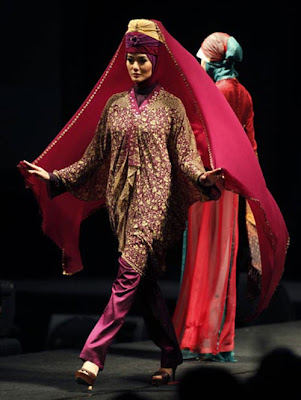According to the Muslim tradition, “the honor of the family resides in the conduct of its women.” “Honor depends on a woman remaining chaste; should she be violated in any way, the men of the family risk being seen as weak and perhaps even being ostracized. Thus, in order to be respected by men, and protected from them, in public a woman should not flout her looks.”
Based on their Qu’ranic principle, women are to “dress modestly in public.”; that is the key. How you define modestly varies from one region to the other. But all in all, Muslim women cover all parts of the body except face and hands. And for public, they mean in the eyes of not only men who are not the woman’s father or brothers, but also in the eyes of women who are not Muslims. According to this, Muslim women must dress modestly whether they appear in front of men or non-Muslim women. An interesting point indeed.
We have seen pictures of Muslim women in dark veils. Most Muslim women today do not wear a full face veil, but wear a scarf called hijab around the head and under the chin. There are several styles and reasons for wearing hijabs- some for religious purpose, but also as traditional clothing.
In the old days, wearing veils is only for royal family, and the rich. Peasants, slaves and prostitutes are not allowed to wear veils. In fact, they would be slashed if disobeyed. So, actually veil wearing was a status symbol only for the rich and powerful. “For a woman to assume a protective veil and stay primarily within the house was a sign that her family had the means to enable her to do so.”
Later on when there was pressure for their community to adapt to the Western way of life, there was a pressure for the women to leave their veil and hijab behind for the modern clothing. A number of Muslim women resist for various reasons: political reasons (you cannot make me abandon my veils if I don’t want to), the sudden banning of veils frightened some, a move against the evil of the West, etc. As a compromise, hijab has been adopted by many as a middle grown. Women can still move around outside their home wearing hijab and still fulfil their traditional/ religious requirements.
To make the matter even more complicated, the lower middle classes around the world tend to be defended in the face of change. A number of rural women in Indonesia and the Philippines resist and feel threatened. “Muslim women began to dress more conservatively as a way to assert who they were.” Some took “part in veiled and silent demonstrations, or could even hide weapons under long robes.” Modernization was seen as negative by many. “Wearing hijab came to symbolize not the inferiority of the culture in comparison to western ways, but its uniqueness and superiority.”
Today there is a trend to revive and create Islamic movements. Women continue to take up hijab as the modest covering.
The Islamic code of dress is observed both for men and women. As women are not to show any body parts except face and hands, the indecent part for men to show in public include the body from the navel to the knee. So, designing men shorts for Muslim is not a good idea.
Women are not to wear any clothes made of thin and/ see-through fabric, or the light can go through. Even hair net is prohibited. Both men and women are not allowed any body-hugging clothes or show contours of the body. Only loose-hanging clothes are allowed. No spandex please.
For men, gold or silk is not allowed either, as they are feminine in nature. Again, silk shirt for men with gold trimming is out.
Enough as the background, next time we’ll get into the demand. You’d be so impressed with the size and market potential. Stay tuned.

















